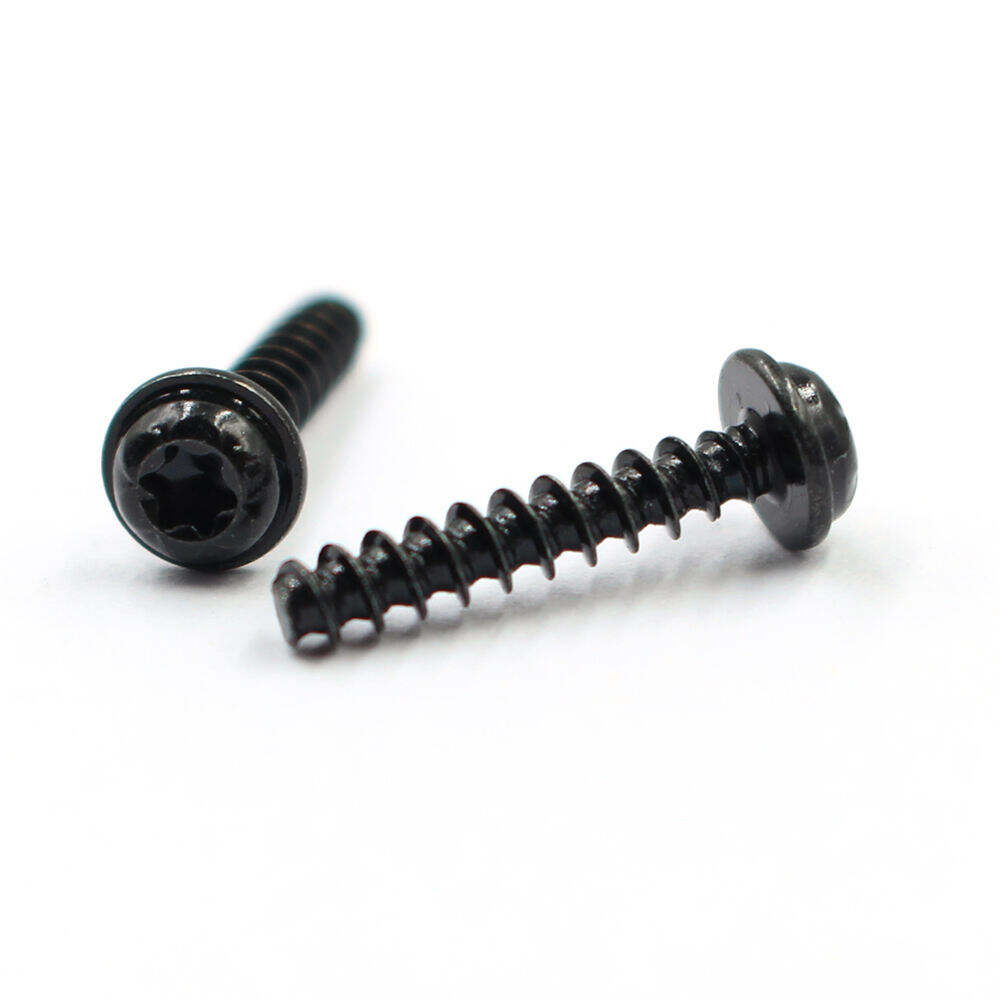Structural Design and Geometric Superiority of Torx Tapping Screws
Star-shaped geometry: How the Torx design enhances driver fit and alignment
Torx Tapping Screws feature that distinctive six-pointed star pattern which creates full 360 degree contact between the driver tool and the actual fastener itself. This design pretty much solves those annoying alignment problems we see all the time with regular cross head screws. According to some recent data from the 2024 Fastener Engineering Report, these screws can handle about 30% more torque than standard Phillips types, and their bits last roughly 22% longer after going through 100 cycles of use. What makes them really stand out though is how they center themselves automatically during installation. This quality proves extremely useful in car manufacturing plants where robots do most of the work. Traditional systems actually replace screwdriver heads quite often because of misalignment issues, something that happens around 72% of the time according to industry observations.
Contact surface analysis: Torx vs. Phillips and Pozi head screws
Independent testing shows Torx screws provide 40% greater effective contact area than PoziDrive and 60% more than Phillips heads under identical loads. This expanded engagement minimizes stress concentration, significantly delaying fastener rounding. Comparative data highlights this advantage:
| Drive Type | Average Stripping Torque (Nm) | Peak Surface Pressure (MPa) |
|---|---|---|
| Torx | 42.7 | 320 |
| Pozi | 31.2 | 490 |
| Phillips | 22.9 | 580 |
Precision engagement and reduced slippage in automated industrial settings
In high-speed CNC environments, Torx's geometric profile reduces driver slippage by 92% compared to cruciform drives according to precision manufacturing studies. The 15° flank angles maintain secure engagement even at feed rates up to 8,000 RPM—essential for aerospace applications requiring 0.02mm positional tolerance.
Higher Torque Capacity and Resistance to Cam-Out
Torque Transmission Efficiency: Why Torx Outperforms Cruciform Drives
The six-lobe configuration of Torx drives provides 56% greater contact surface than Phillips heads, dramatically improving torque transfer efficiency. This translates into superior performance:
| Performance Metric | Torx Drive | Phillips Drive |
|---|---|---|
| Maximum Torque Capacity | 72% Higher | Baseline |
| Cam-out Prevention | 89% Reduction | Frequent Occurrence |
Industrial fastener analyses confirm Torx systems sustain tool engagement beyond 40 Nm, whereas Phillips drives typically fail above 23 Nm. In heavy machinery production, this reliability leads to 63% fewer tool replacements in Torx-based lines.
Cam-Out Prevention in High-Speed Assembly Environments
With a 15° flank angle, Torx drives resist cam-out even at robotic speeds exceeding 1,200 RPM. Unlike Phillips screws—which experience 38% slip under lateral load—Torx fasteners maintain concentric engagement through 10,000+ cycles in demanding automotive transmission plants.
Mechanical Stability During Tool Engagement Under Load
Torx screws withstand 400N of lateral force without deflection, an 89% improvement over Phillips drives in vibration tests simulating mining equipment operation. Finite element analysis shows their geometry reduces radial stress concentrations by 62%, preventing thread deformation during high-load applications.
Durability and Long-Term Performance in Demanding Conditions
Wear Resistance After Repeated Insertion and Removal Cycles
Torx tapping screws retain structural integrity over 100+ installation cycles, outlasting Phillips screws by 50% in controlled wear tests (2023 Industrial Fastener Report). Their star geometry evenly distributes pressure across contact points, minimizing head stripping and tool degradation. This durability cuts fastener replacement costs by $4,800 annually in automotive manufacturing.
Performance in High-Vibration and Corrosive Industrial Environments
Industrial-grade Torx screws with specialized coatings endure over 2,000 hours of salt spray exposure—three times longer than standard zinc-plated cross-head alternatives. In extreme settings like offshore drilling platforms, they demonstrate:
- 90% torque retention after six months of continuous vibration
- 40% slower corrosion rates in chemical processing environments
A 2024 materials analysis found that the optimized flange-to-shank ratio prevents micro-crack formation during thermal cycling, addressing a key failure mode in legacy screw designs.
Proven Reliability in Critical Industrial Applications
Automotive manufacturing: Torx screws in engine and chassis assembly
The automotive industry has pretty much made Torx tapping screws the norm because they just don't come loose when things get shaken around. According to a recent industry check in 2023, switching from those old Phillips head screws to Torx reduced problems with fasteners failing inside engine blocks by about two thirds. And guess what? The tools used lasted almost 40 percent longer too during those 2,000 cycle tests. Why does this happen? Well, these Torx screws have this neat six point contact design that keeps them locked in place even when temperatures swing wildly between minus 40 degrees Celsius and a scorching 150 degrees Celsius inside powertrain parts. Makes sense why manufacturers keep going back to them time and again.
Aerospace and heavy machinery: High-stress fastening requirements
The Aerospace Materials Performance Report (2024) confirms Torx screws handle 38% higher shear loads than cross-head alternatives in wing spar assemblies. Their geometric stability is crucial in mining equipment exposed to 12G vibration levels, where Pozi drives exhibited 79% higher failure rates after 500 operational hours.
Case study: Field performance data from Yuhuang Technology Lechang Co Ltd
A 14-month trial at an electric vehicle battery plant showed Torx screws increased assembly line efficiency by 23%. Maintenance records indicated:
| Metric | Torx Tapping Screws | Phillips Screws |
|---|---|---|
| Weekly replacements | 12 | 89 |
| Average torque loss | 1.2 Nm | 4.7 Nm |
| Stripped head incidents | 0.3% | 11.8% |
Reduced cam-out frequency enabled high-speed robotic installers to achieve 99.4% first-pass yield in chassis mounting, reinforcing Torx's role as the preferred solution for industrial reliability.
Frequently Asked Questions
What is the primary design feature of Torx Tapping Screws?
Torx Tapping Screws have a six-pointed star pattern that creates a full 360-degree contact between the driver tool and the fastener, enhancing fit and alignment.
How do Torx screws compare to Phillips and Pozi in terms of contact area?
Torx screws provide 40% greater effective contact area than PoziDrive and 60% more than Phillips heads, minimizing stress concentration and delaying fastener rounding.
Why are Torx screws preferred in industrial applications?
Torx screws are chosen for their superior torque transmission efficiency, reduced slippage, better cam-out prevention, and higher mechanical stability under load conditions.
What is the durability of Torx screws in harsh environments?
Torx screws with specialized coatings can endure over 2,000 hours of salt spray exposure and retain torque even after six months of continuous vibration in corrosive environments.

